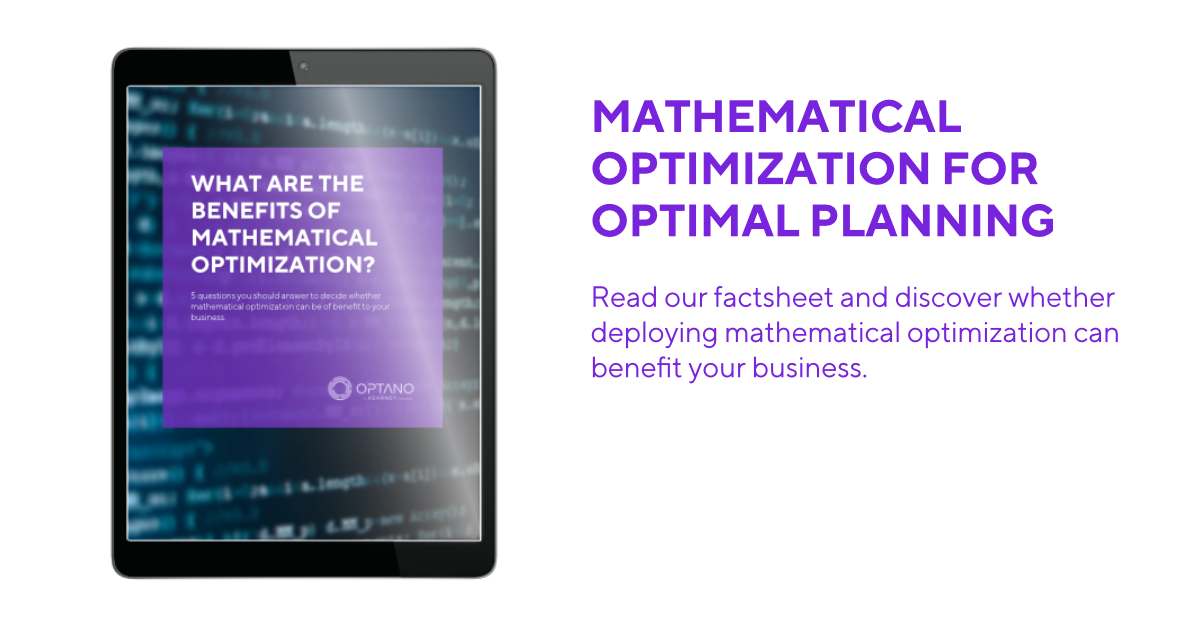Optimizing the product portfolio
Recently, I have often found myself standing in front of empty shelves in supermarkets. The reason for this was not, however, delivery problems or increased demand, as we know from coronavirus times, but because the manufacturer and retail group were unable to agree on the conditions and the retail group removed the products from its portfolio (for the time being).
Product portfolio decisions are equally important for retail groups and the manufacturing industry: which products should be retained because they are profitable and popular? Which ones are rarely bought but increase storage and production costs?
In the following blog post, we examine which aspects play a role in product portfolio management and how companies can draw clear profitability boundaries by specifically optimizing their product portfolio, regardless of their industry.
The art of product portfolio optimization
Recognizing and understanding correlations...
Optimizing the product portfolio can be a real challenge, especially at a time when customers expect a wide choice and constant availability.
Looking at each product individually, it is still relatively easy to consolidate all costs and profits and show whether a product is profitable or not. To do this, it is sufficient to consolidate and then analyze the figures from all departments, from procurement to sales.
In most cases, however, an isolated analysis is not enough: For example, there are deadweight effects that are not taken into account in the individual analysis. Customers buy a product that would not be profitable on its own, but at the same time take other high-margin products with them. In the example of the retail trade, this would be the popular weekly offers, which do not generate any profit on their own, but attract customers who then do their entire weekly shopping. In this case, a product would not be profitable on its own, but would generate a high profit with other products.
Another example of cross-dependencies in the product portfolio are entry-level products: These are products that generate little or no profit on their own, but ensure that customers become loyal to a provider and remain loyal to them in future purchasing decisions.
...and draw the right conclusions
Recognizing and displaying the relationships between products is not trivial. There is often a lack of effective product management that brings together the complex interrelationships from procurement to sales and enables clear statements to be made about which products in the range are actually profitable and which are not and why. In such cases, there is a risk that resources and production capacities will be channeled into unprofitable products instead of those that generate profits and strengthen competitiveness.
It becomes clear how important it is to effectively optimize the product portfolio to ensure that the products on offer actually make the best use of the available resources and achieve the greatest possible overall profit.
While the factors mentioned are already complex interrelationships and quantifying them is not trivial, there are other factors where this is even more difficult. This often involves questions of image: How is a company perceived by customers? Certain products must be retained for the overall image, even if they do not generate much profit individually and in relation to other products. The supermarket portfolio can be used as an example of organic products, whose margins are lower than those of conventional products, but which are necessary for a sustainable image.

Are you interested in our factsheet?
What are the benefits of mathematical optimization?
In a nutshell:
These aspects make portfolio decisions complex
When making decisions about the product portfolio, many aspects that have a complex impact on the overall portfolio must therefore be considered in addition to the individual contribution margins:
- Product diversity
- Companies can have a variety of products in their portfolio that are subject to different product life cycles and require different market conditions.
- Competitive environment
- The competitive environment is constantly changing. In order to remain competitive, companies must monitor their competitors’ offerings and position their own accordingly.
- Resource allocation
- Companies have limited resources such as time, money and personnel. Deciding which products to keep or abandon requires careful allocation of resources.
- Interdependencies
- It often happens that products that generate little or no profit themselves enable the sale of other products, which in turn generate a high profit.
- Image
- Some products must be retained because they are indispensable for the company’s image. The damage to image caused by the discontinuation of these products would be greater than the cost of retaining them.
- Overall portfolio / customer loyalty
- There are products that are not profitable on their own but are necessary to round off the overall portfolio.
- Future viability
- The product may have been launched too early or there may be other external reasons why a product does not sell over a certain period of time. With new products in particular, it is advisable to analyze the current situation and possible reasons in detail and only then make a decision.
- Contractual commitments
- Long-term framework agreements can be the reason for keeping products in the portfolio that have low sales figures and are unprofitable. In most cases, terminating such a contractual obligation would be more expensive than keeping the product in the portfolio.
It is clear that decisions for or against a product in a portfolio cannot simply be made on the basis of current profits. At the same time, these are of course the decisive values for the company, as a good image alone does not generate profit.
However, technical methods can be a good tool for maintaining an overview of all product variants and optimally stocking the portfolio.
More interesting articles
The road to success: Step by step to the optimal product portfolio ?
During the initial analysis of the product portfolio, it is important to obtain a detailed overview of all products on offer and possible alternatives. All cost factors for the entire supply chain must be considered and all data on previous sales must be compiled. For products that were not previously on offer, realistic forecasts of costs and potential sales must be drawn up.
This data can then be prepared in such a way that all dependencies in the value chain can be identified and presented transparently. This creates a basis for decision-making that clearly presents the potential and risks within the product portfolio and enables fact-based conclusions to be drawn.
This is where mathematical methods based on the created database can offer decisive advantages, as the aim is to get the best out of limited resources. If, for example, capacities and resources are freed up by eliminating products, more profitable products can take their place. This applies both to shelf space in the supermarket and to production capacity in the manufacturing plant. However, selecting the right products is not trivial due to the many cross-dependencies. This is where mathematical optimization can provide fast and, above all, optimal solution proposals as to which products can best be used to fill the capacities and resources that are freed up.
Another possibility offered by mathematical methods based on existing data is the simulation of the results of different decisions. By modeling interdependencies, all the effects of decisions can be simulated and presented in terms of costs and revenues: What revenue will be lost if we no longer offer this or that product? What capacities will be freed up in return? Which products can be offered and what profit will be made?
Such scenarios can be particularly helpful when deciding on unprofitable products that should remain in the portfolio for other reasons (e.g. image or customer loyalty): If you can quantify exactly what costs a product incurs and what profit you could make if you were to discontinue it, you can better decide whether the soft factors are sufficient to retain it.
OPTANO is the key to successful portfolio analysis
In product portfolio management, the use of mathematical methods can offer a decisive advantage when it comes to making data-based decisions and efficiently optimizing a company’s portfolio.
Thanks to OPTANO’s advanced technologies and algorithms, correlations can be modeled particularly well and presented in an understandable way, enabling decision-makers to make informed strategic decisions. The visualization of portfolio information makes it easier to recognize patterns, understand relationships and identify opportunities to optimize the product portfolio.
A key added value of OPTANO solutions are the what-if scenarios, which offer a wide range of options for analyzing the effects of changes in the product portfolio. This allows companies to simulate various strategic decisions in advance and evaluate their impact on sales, profitability and market share. With the help of these scenarios, companies can make well-founded decisions and adapt their product portfolio to constantly changing market requirements.
The optimal product portfolio
Product portfolio management is characterized by complex interdependencies. This makes it difficult to make well-founded decisions. Use the possibilities of digitalization and mathematical methods to make decisions on an optimal basis and create the optimal product portfolio.
Have you already got our factsheet on this topic?

In our factsheet “What are the benefits of mathematical optimization?” we ask 5 questions to help you assess whether mathematical optimization brings benefits to your organization.
To obtain our factsheet, all you need to do is enter your contact details in the space below. A pop-up window will then open to download the whitepaper. Please note that by providing us with your email address, you agree that we may contact you on this topic. You may revoke this agreement at any time by contacting privacy@optano.com.






